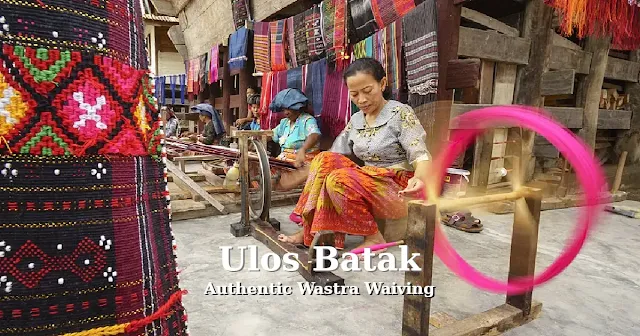Wastra - Journey into the heart of Ulos Batak, an emblem of Wastra heritage. In the enchanting village of Jangga, skilled artisans weave intricate tales of cultural pride, creating Ulos as a timeless symbol of love, tradition, and Batak heritage.
 |
| Ulos Batak Artisan In Huta Raja - Source Wikiimage |
Wastra Nusantara stands as one of Indonesia's cultural gems, a treasury of traditions woven into the fabric of the archipelago. Derived from Javanese and Balinese, the term "wastra" finds its roots in Sanskrit, meaning "clothing or garment." Translated, Wastra Nusantara signifies "Fabrics from the Indonesian Archipelago."
Each region contributes to this rich tapestry with its distinct literature, showcasing a blend of unique materials, motifs, colors, and sizes.
Appellation Of Wastra From Region To Region
Wastra Nusantara is a timeless heritage, a legacy passed down through generations, enriching Indonesian culture. With profound social significance, each piece of wastra carries its own narrative, adding a unique chapter to its storied history. Laely passionately emphasizes, "Wastra Nusantara holds deep philosophical values. Understanding them fosters love and pride for our nation, instilling a commitment to its preservation. Loving literature means cherishing, studying, using, and safeguarding it."
The Names of Wastra
- Ulos from Batak
- Songket from Malay and Minang
- Batik from Java
- Lurik from Java
- Tapis from Lampung
- Sasirangan from Banjar Kalimantan
- Ulap Doyo from Dayak Banuag East Kalimantan
- Ikat, Buna, and Lotis from Nusa Tenggara Timur
- Bentenan from Minahasa, Sulawesi
- Lipa Sabbe from Bugis Sulawesi
- Sa'dan from Toraja Sulawesi
- Tanimbar from Maluku
Each name resonates with cultural significance, reflecting the diverse heritage of Indonesia's archipelago through the artistry of wastra.
Ulos Batak - A Tapestry of Heritage and Meaning
 |
| Ulos Batak In Dancing Ceremony |
Cultural Significance and Warmth
For the Batak people, Ulos represents more than just warmth; it symbolizes bravery for men and strength against infertility for women. Originating from the necessity of living in cold mountainous regions, Ulos evolved into a symbol of love, traditional ceremonies, and societal structures. Believed to possess magical religious powers, Ulos is considered 'sacred,' offering protection to the wearer.
Diverse Motifs and Symbolic Meaning
Ulos comes in various kinds and motifs, each carrying its own meaning. Whether used in weddings, births, deaths, or other rituals, Ulos is an integral part of Batak traditions. The choice of Ulos, be it Ragidup, Sibolang, Runjat, or others, depends on the occasion and the wearer's role. Some Ulos, like Jugja, Sadum, Ragidup, and Runjat, are reserved for special occasions due to their sacred value.
Cultural Heritage and Symbol of Love - Mangulosi
In Batak culture, giving Ulos, known as mangulosi, is a powerful cultural heritage symbol of love. However, it comes with rules; only individuals with family relations can perform mangulosi. Parents can mangulosi their children, and there are specific Ulos, like Ragidup Sinagok, for unique events like a child giving birth to their first child. Ulos Ragidup Silingo is reserved for special guests, emphasizing the wastra Nusantara cultural depth woven into every fabric of Ulos.
Where to Meet the Authentic Ulos Batak Maker
 |
| Ulos Batak Maker in Jangga Village |
Ulos Weaving in Action
Jangga is renowned for its skilled women who intricately weave the beautiful Ulos cloth. As you stroll through the village, you'll have the unique opportunity to observe these talented artisans crafting complex Ulos patterns right in front of their traditional houses. The weaving process unfolds as a living testament to the enduring significance of Ulos in the fabric of traditional Batak society.
Traditional Batak Life Unveiled
Jangga village, situated on the edge of Mount Simanuk-Manuk in Toba Samosir Regency, North Sumatra, is a time capsule of the original Batak culture. Approximately 24 km from Lake Toba, this village stands among a handful of authentic Batak villages that have retained their cultural essence.
Exploring Cultural Heritage
Embark on a journey through rows of traditional houses, each standing as a silent storyteller of the region's history. Discover cultural and historical gems, including remnants of Batak kings like King Tambun and the monument to King Manurung. Marvel at the architecture of traditional Batak houses with their distinctive stilts and large roofs, and delve into the captivating cultural heritage by visiting the monumental tributes to the kings of yesteryear.
A Glimpse into Authentic Batak Life
Jangga village offers a rare opportunity to experience traditional Batak life in a setting untouched by the modern world. Wander through the village lanes, witness the art of Ulos weaving, and absorb the tranquil atmosphere. It's an enriching cultural tourism experience that provides insight into the roots of the Ulos tradition and the profound connection between the Batak people and their heritage.
Plan your visit to Jangga village and step into a world where the authenticity of Ulos Batak comes alive in the hands of dedicated artisans, carrying forward a legacy woven with stories of love, tradition, and cultural pride.